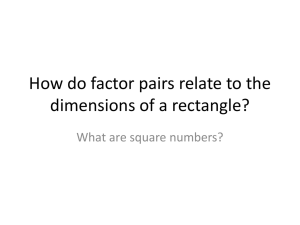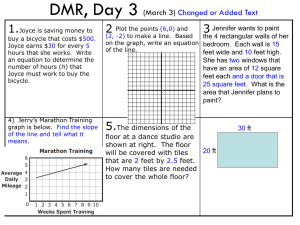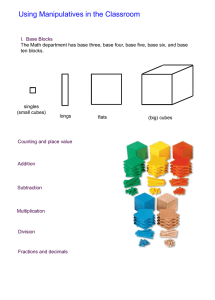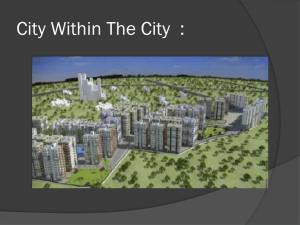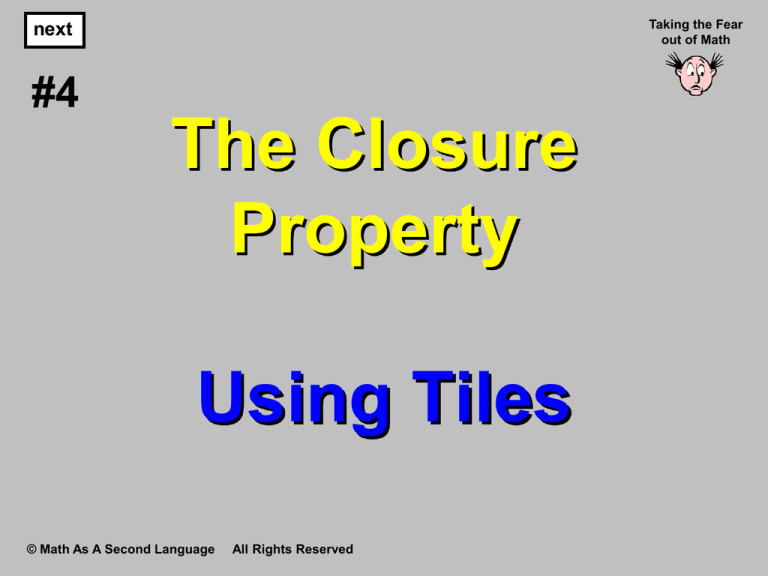
Taking the Fear
out of Math
next
#4
The Closure
Property
Using Tiles
© Math As A Second Language
All Rights Reserved
next
In this presentation we will show how by
using tiles, the closure properties for
addition and multiplication become obvious.
To begin with, closure under addition means
that the result of adding two whole numbers
is also a whole number.
Let’s look at two sets, one of which has
3 tiles and the other of which has 2 tiles.
© Math As A Second Language
All Rights Reserved
next
If we move the two sets of tiles closer
together, they become a (larger) set
that consists of 5 tiles,
as shown above.
The above explanation is easy for even
very young children to internalize, and
they easily generalize this for any two
whole numbers.
© Math As A Second Language
All Rights Reserved
next
For example, to show that since 5 and 6
are whole numbers so also is 5 + 6, all they
would have to do is arrange 5 red tiles and
six blue tiles as shown below…
…and then move the two sets closer
together to obtain one larger set of tiles…
© Math As A Second Language
All Rights Reserved
next
While the closure property for addition
seems pretty much self evident, it is
not a truism in general that when you
“combine” two members of a set the
result will be another member of the set.
In terms of a non-mathematical
example that students might have fun
working with, define the combination
of two colors to be the color you get when
the two colors are mixed together.
© Math As A Second Language
All Rights Reserved
next
Suppose we take the set of colors that
consists only of red, yellow, and blue.
In that case if we combine the red and
yellow, we do not get a member of the set.
Yes, we do get the color orange, but orange
does not belong to the set that consists only
or red, yellow, and blue.
© Math As A Second Language
All Rights Reserved
next
In terms of a more mathematical
example, notice that the sum of two odd
numbers is never an odd number (this will
be proven in a later presentation)!
1 2 3
1
4
1
2
3
1
4
2
5
3
6
In other words, the set of odd numbers
is not closed with respect to addition.
© Math As A Second Language
All Rights Reserved
next
Also notice that while addition and
subtraction (i.e., unaddition) seem closely
connected, the whole numbers are not
closed with respect to subtraction.
While we can delete 2 tiles from a set that
contains 3 tiles…
…we cannot delete 3 tiles from a set that
contains only 2 tiles.
© Math As A Second Language
All Rights Reserved
next
In other words, even though 2 and 3
are whole numbers, 2 – 3 is not
a whole number.1
note
1 To
extend the whole numbers so that they will be closed with respect
to subtraction, we had to invent the integers (the whole numbers and the
negative whole numbers). In the language of integers, the whole number 1 is
written as +1 and read as “positive 1” while its opposite is written as -1 and
read as “negative 1”; and in the language of integers, 2 – 3 = +2 – +3 = -1.
Thus, the integers are closed with respect to subtraction.
© Math As A Second Language
All Rights Reserved
next
Using tiles, it is easy to see that the set
of whole numbers is also closed with
respect to multiplication; that is, the result
of multiplying two whole numbers is also a
whole number.
In terms of a specific example, we know
that 4 and 3 are whole numbers, so let’s
use tiles to demonstrate that 4 × 3 is
also a whole number.
© Math As A Second Language
All Rights Reserved
next
To this end, we may visualize 4 × 3 as
4 sets, each with 3 tiles…
…and if we move the 4 sets of tiles closer
together, we get one (larger) set of tiles.
© Math As A Second Language
All Rights Reserved
next
In fact, we can introduce students to
area in a very non threatening way by
rearranging the 4 sets of 3 tiles into a
rectangular array such as…
© Math As A Second Language
All Rights Reserved
next
Notice that by our fundamental
principle of counting…
…and…
…have the same number of tiles (12).
© Math As A Second Language
All Rights Reserved
next
Just as the whole numbers, which
are closed with respect to addition,
but not closed with respect to
subtraction; the whole numbers are
also closed with respect to
multiplication but not closed with
respect to division.
© Math As A Second Language
All Rights Reserved
next
For example, 14 ÷ 3 cannot be a whole
number because if we count by 3’s, 4 × 3
is too small to be the correct answer while
5 × 3 is too large to be the correct answer;
and there are no whole numbers
between 4 and 5.
In terms of our representing whole
numbers in a rectangular array, 14 tiles
cannot be arranged in such a pattern if
each row is to consist of 3 tiles.
© Math As A Second Language
All Rights Reserved
next
We would need 1 more tile in order to
complete the 5th row of tiles.
No matter how self-evident the closure
properties seem to be in terms of tiles,
later in their study of mathematics
students will be exposed to a more general,
and more abstract definition of closure.
© Math As A Second Language
All Rights Reserved
next
In particular…
The Closure Property For Addition
If a and b are whole numbers, then a + b
is also a whole number.
The Closure Property For Multiplication
If a and b are whole numbers, then a × b
is also a whole number.
© Math As A Second Language
All Rights Reserved
next
However, by already having
internalized these two concepts
in terms of tiles the formal
definitions will not
intimidate students.
© Math As A Second Language
All Rights Reserved
next
Closing Notes on Closure
Closure states that the sum of two whole
numbers is a whole number, but it does not
state what the whole number is. Thus the
fact that we showed 5 + 6 = 11 goes beyond
what closure guarantees.
Likewise, closure also states that the
product of two whole numbers is a whole
number, but it does not state what the whole
number is. Thus the fact 3 × 4 = 12 goes
beyond what closure guarantees.
© Math As A Second Language
All Rights Reserved
next
In our next presentation, we shall
discuss how using tiles also helps us
better understand the commutative
properties of whole numbers with
respect to addition and multiplication.
© Math As A Second Language
All Rights Reserved
next
We will again see that
what might seem
intimidating when
expressed in formal terms
is quite obvious when
looked at from a more
visual point of view.
© Math As A Second Language
All Rights Reserved
5+3
5×3
closure
addition
multiplication



